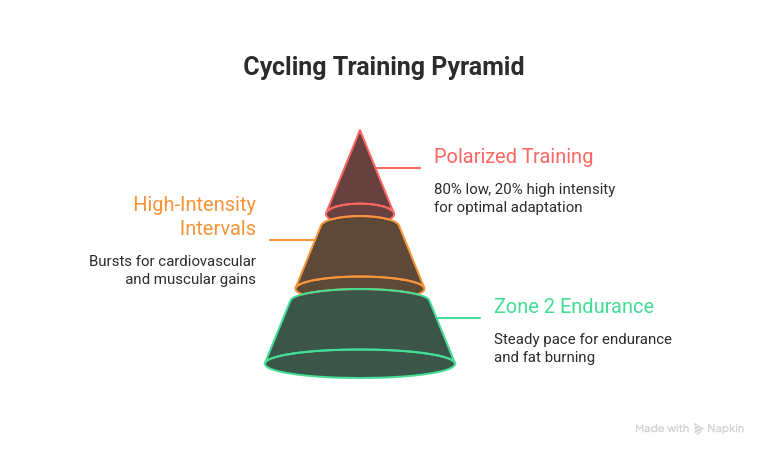10 Cycling Training Tips to Boost Your Endurance in Just 4 Weeks

Endurance is the golden currency of cycling. Whether you’re tackling a Sunday club ride, chasing a personal best in a sportive, or eyeing up the start line of a gran fondo, it’s the engine that keeps you moving strong long after the initial rush fades. Without it, the final miles can feel like a slowmotion collapse.
The good news? Endurance isn’t just for the seasoned pros with thousands of miles in their legs. With the right training structure, commitment, and a smart mix of ride types, you can see tangible improvements in as little as four weeks. The process isn’t magic—it’s science meeting consistency.
In the next sections, you’ll discover 10 targeted strategies, each grounded in proven training principles and tested by real world riders. Think of this as your blueprint: a blend of sports science, practical hacks, and mindset shifts designed to help you go further, faster, and with more confidence.
The Foundation
Know Your Limits and Assess Fitness
Before you start piling on the miles, you need to know where you’re starting from. That’s where a Functional Threshold Power (FTP) test—or an equivalent baseline assessment—comes in. Your FTP represents the highest average power you can sustain for about an hour, and it’s the gold standard for setting personalised training zones.
Why does this matter? Because cycling endurance isn’t built by guessing effort levels—it’s built by training at the right intensities. Once you know your FTP, you can target the sweet spots:
- Endurance Zone (steady, sustainable pace) to condition your cardiovascular system
- Tempo Zone for controlled efforts that push your aerobic limits
- Interval Zone for short, challenging bursts that develop speed and power
Without this baseline, you risk riding too hard on easy days or too easy on hard days—both of which blunt progress.
To test your FTP, you can use platforms like Join.cc’s FTP Guide or structured plans from TrainerRoad’s Testing Protocol. Even a simple 20 Intensity Intervals
Endurance isn’t built solely in the slow lane. Adding 4–10 minute bursts at 80–90% of your maximum heart rate, with equal or slightly longer recovery periods, delivers a potent mix of aerobic and muscular gains. These sessions push your cardiovascular system to its limits, boost your ability to sustain higher speeds, and build mental toughness for when the road turns uphill or the wind picks up.
You might start with three intervals in a session, building to five or six over the weeks. Whether on the road or a smart trainer, keep the efforts controlled—hard but repeatable—rather than going all out on the first rep and fading fast.
Embrace Polarized Training
The 80/20 principle is simple: spend roughly 80% of your training time at low intensity (think Zone 1–2) and 20% at high intensity (Zone 4–5). This approach works because it maximizes adaptation while minimizing fatigue, giving your body the recovery it needs between hard efforts.
For a typical rider training five days a week, that might mean four days of endurance rides and one day of structured high intensity work. By keeping the “easy” rides genuinely easy, you have the energy to hit your hard days with full force—leading to faster gains without the burnout.

Smart Progression
Progressively Increase Training Load
Your body adapts to the stress you put it under—but only if you increase that stress gradually. This is the principle of progressive overload. In cycling, that might mean:
- Adding 10–15 minutes to your long ride each week
- Increasing the number of intervals in a session
- Riding an extra day per week during the final two weeks of your plan
The key is subtlety. Push too fast, and you risk fatigue or injury; progress slowly, and you’ll build endurance steadily and safely.
Don’t Skip Strength Training
Cycling may be a leg dominant sport, but off-the-bike strength work builds the durability and power to pedal harder for longer. Compound exercises like squats, lunges, and deadlifts target the major muscle groups you rely on when riding.
Two strength sessions per week even just 20–30 minutes each—are enough to improve muscular endurance, protect your joints, and enhance overall stability on the bike. You don’t need a full gym membership; bodyweight work and resistance bands can still deliver results.
Supporting Your Training
Prioritize Nutrition and Hydration
You can’t build endurance on an empty tank. On training days, carbohydrates are your primary fuel especially for long rides and intervals. Aim to top up your glycogen stores with a carb rich meal the night before a big ride and a balanced breakfast (think oats, fruit, and yogurt) on the morning of.
During rides longer than 90 minutes, plan to consume 30–60g of carbs per hour through energy gels, bars, bananas, or a sports drink to maintain performance. After training, pair protein with carbs to accelerate recovery and muscle repair.
Hydration is just as critical. Start every ride well hydrated, sip regularly, and consider electrolyte drinks for longer or hotter sessions to replace sodium and other key minerals lost through sweat.
Rest and Recovery are Essential
Improvement doesn’t happen while you’re riding—it happens while you’re resting. Schedule at least one full rest day per week to allow your muscles, joints, and nervous system to adapt. Every fourth week, reduce your training volume by 30–50% a deload week to consolidate gains and prevent burnout.
Watch for signs of overtraining: persistent fatigue, irritability, reduced performance, trouble sleeping, or a resting heart rate that’s unusually high. If you notice these, dial back intensity or take extra rest days. Sometimes the smartest move for endurance is to put your feet up.
Tracking and Motivation
Make Progress Measurable
Training is more motivating when you can see the results. Use heart rate monitors, power meters, or perceived exertion scales to track your rides. Establish baseline metrics like how far you can ride in 60 minutes at a given heart rate then repeat the same test every two weeks to measure improvement.
Field tests could include:
- A 20 minute FTP test to track power gains
- A set climb at a fixed effort to monitor speed and efficiency
- A time trial loop you repeat under similar conditions
These numbers don’t just guide your training—they prove that your effort is paying off.
Mix in Variety and Stay Engaged
Endurance grows with consistency, but motivation thrives on novelty. Keep things fresh by changing your routes, mixing road, gravel, and indoor rides, or joining a local group ride for a social boost. Throw in the occasional challenge like a hill climb you’ve avoided or a distance milestone to keep yourself mentally invested.
The more you enjoy the process, the more likely you are to stick with it. And in endurance training, showing up consistently beats going hard occasionally every time.
Conclusion
Four weeks might not turn you into a Tour de France contender, but with structured training, smart variety, and proper recovery, you can noticeably boost your cycling endurance in that time. The formula is simple: know your numbers, balance long steady rides with targeted intensity, fuel and hydrate wisely, and give your body the rest it needs to adapt.
To keep the momentum going, set yourself a goal event or personal challenge whether it’s a 100km charity ride, a hilly sportive, or simply conquering a route you’ve never dared to try.
Having a concrete target keeps you accountable and turns your training into a journey with a clear finish line.
For deeper insights, structured plans, and expert tips, explore:
- Join.cc – Endurance Cycling Tips
- Robertovukovic.com – Cycling Training Advice
- GCN YouTube – Polarized Training Explained
- TrainerRoad – Training Plan Guide
Your endurance is built one pedal stroke at a time—so clip in, roll out, and make these next four weeks count.
FAQ – Boosting Your Cycling Endurance
1. Can I really improve my cycling endurance in just 4 weeks?
Yes if you follow a structured plan that combines long, steady rides, targeted intervals, proper recovery, and good nutrition. While 4 weeks won’t maximise your lifetime potential, it’s enough to see noticeable gains in stamina and riding efficiency.
2. How many days a week should I train?
For most riders, 4–5 days per week is ideal. This allows enough volume to stimulate endurance adaptations while still leaving room for rest and recovery days.
3. Do I need a power meter to follow this plan?
No. A power meter is a precise tool for measuring effort, but you can train effectively using heart rate zones or even perceived exertion. Many cyclists start without power data and still see strong results.
4. What should I eat during long rides?
For rides over 90 minutes, aim for 30–60g of carbs per hour. This can come from energy gels, sports drinks, bananas, or snack bars. Don’t forget to drink regularly and replace electrolytes in hot conditions.
5. How do I avoid overtraining while building endurance?
Schedule at least one full rest day each week, reduce your training volume every fourth week, and watch for signs of overtraining—such as persistent fatigue, irritability, or declining performance. Listening to your body is just as important as following the plan.